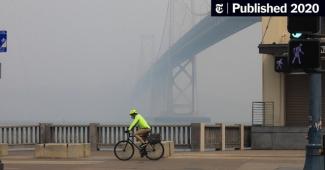
Editor's Note: The following digital museum highlights ideas and research concerning relationships between exercise and air pollution -- in the form of links to original research, an infographic, presentations, media articles and interviews. Resources featured here are based around research conducted by Dr. Michael Koehle and a range of collaborators as well as public engagement activities carried out by Dr. Koehle. Dr. Koehle is a Professor, Division of Sport & Exercise Medicine & School of Kinesiology, and Director of the Environmental Physiology Laboratory -- University of British Columbia.
With climate change, we can expect air quality to continue to get worse. More severe and frequent heat waves and heat domes lead to higher levels of ground-level ozone. At the same time, increased wildfire activity leads to more frequent and prolonged periods of intense particulate matter air pollution. Likewise, air pollution, and specifically carbon particles in the air can accelerate climate change by reducing the albedo of the Earth’s surface and leading to greater absorption of heat energy from the sun. The adverse health effects of air pollution are incontrovertible. Air pollution increases mortality and causes or worsens a multitude of diseases, including chronic obstructive pulmonary disease, diabetes, dementia and heart disease.
By contrast, physical activity and exercise are powerful tools for both prevention and treatment of disease. Through practices such as active commuting, we can somewhat reduce our impact on the climate. However, exercise increases our metabolism, and therefore the amount of air pollution that gets ingested. Furthermore, intense exercise can lead to more mouth breathing and less nasal breathing, bypassing the humidification and filtration functions of the nose. Thus, with an increase in inhaled dose of air pollution there is a potential for an increased risk for the negative consequences of air pollution.
Fortunately, and as you can explore below, the evidence is strong that, even in areas of poor air quality, a physically active lifestyle leads to significant health benefits. The focus of our research is to study the interaction between physical activity and air pollution and to develop strategies to reduce the risks of air pollution while enabling individuals to stay physically active. We use a variety of methods including direct exposure studies in the laboratory, field studies, and epidemiological methods to help to understand the complex interaction between pollution and exercise.
The following infographic, based on the Hung et al. (2023) article cited in the 'Academic Articles' section below, shows some protective strategies that people can consider when contemplating whether or not to exercise in air pollution.


Exercise & air pollution in the media
Outside Magazine: How to train (and compete) in dirty air
The Washington Post: Is it safe to exercise outdoors when the air quality is bad?
The New York Times (see photo): Is it safe to exercise if the air is hazy with wildfire smoke?
The Globe and Mail: What's more important, getting that workout in, or staying inside during air quality warnings?
The Physiological Society: How does air pollution affect our health?
Podcasts
FastTalk Laboratories Podcast: Environmental pollution, health, and performance with Dr. Michael Koehle
The Train Right Podcast
Marathon Medic Podcast
Recorded webinars and conference presentations
Physical Activity and Air Pollution webinar
Virtual Environmental Ergonomics Series
Sports Cardiorespiratory Conference
Academic articles
Digital Museum Credits
Lead author: Dr. Michael Koehle, UBC, michael.koehle@ubc.ca



